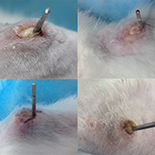Ineffectiveness of N-[(2-Hydroxyl-3-Trimethyl Ammonium)Propyl] Chitosan Chloride Coating in Prevention of Pin Tract Infection: An In Vivo Study
Vidmi Taolam Martin, Chandan Kumar, Wang Lei, Zhang Xiang, Hou Yi Long, Zhang Xian Rong, Rong Zeng, Yaozi Long, Deqiang You, Mayun Fei, Welera Haissou Elodie, Mei Tu, Yu Bin
Med Sci Tech 2017; 58:34-41
DOI: 10.12659/MST.903420
Available online: 2017-04-13
Published: 2017-04-13

BACKGROUND:
The aim of this study was to investigate the in vivo efficacy of an implant coated with HTCC in prevention of pin tract infection, a major complication in orthopedic surgery, in comparison with an uncoated implant.
MATERIAL AND METHODS:
Twenty-four mature male white rabbits were randomized into 2 equal groups (N=12). HTCC-coated implants were used in the experimental group and uncoated implants in the control group. The implants were colonized with 1×106 colony-forming units (CFU) of Staphylococcus aureus and inserted into the lateral aspect of the right proximal tibiae (1 implant per rabbit). In each group at 2 and 4 weeks after surgery, 5 and 7 rabbits were sacrificed, respectively, to harvest the soft tissues around the pin tract for histological analysis, radiographic examination, and gross observation of the surgical sites.
RESULTS:
After 4 weeks, 100% of the uncoated implants showed signs of infection, while 75% of the HTCC-coated implants were infected.
CONCLUSIONS:
HTCC coating was not effective in prevention of pin tract infection.
Keywords: Anti-Bacterial Agents, Chitosan, Models, Animal



